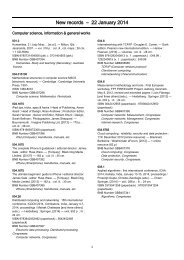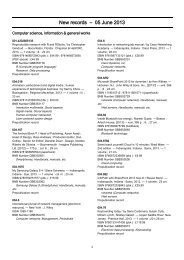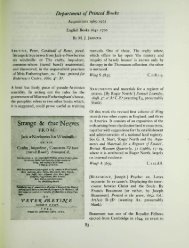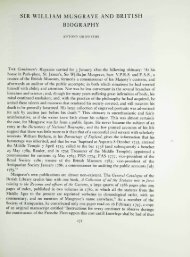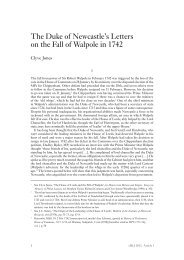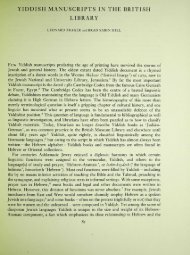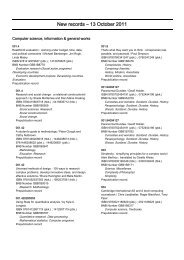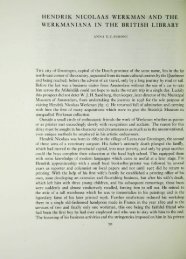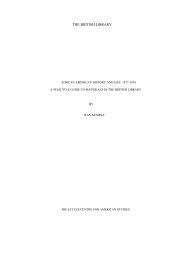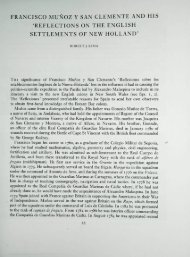A Medieval Psalter 'Perfected': Eighteenth-Century ... - British Library
A Medieval Psalter 'Perfected': Eighteenth-Century ... - British Library
A Medieval Psalter 'Perfected': Eighteenth-Century ... - British Library
Create successful ePaper yourself
Turn your PDF publications into a flip-book with our unique Google optimized e-Paper software.
A <strong>Medieval</strong> <strong>Psalter</strong> ‘Perfected’: <strong>Eighteenth</strong>-<strong>Century</strong> Conservationism and an Early (Female) Restorer<br />
of Rare Books and Manuscripts<br />
of her scribal work is the handling of the ruling: while the ruling in this manuscript has been<br />
carried out in black, Denyer has ruled her pages in red, presumably in deference to a common<br />
medieval practice.<br />
Less imitative, but still in the spirit of the original, is Denyer’s execution of the manuscript’s<br />
graphic elements. On every page that replaces a folio from which a miniature was extracted,<br />
Denyer supplied a border that frames the main text block with a gold bar on each side<br />
(fig. 10). Strung vertically through the middle of each gold bar is a thick line, half of its<br />
length blue and the other mauve, terminating in a knot at each corner. Entwining each side<br />
of the border are feathered leaves in green, blue and mauve, which give rise to an array of<br />
sprigs, wisps, tendrils and minute gold spheres. None of these borders replicates the two<br />
medieval examples which remain in the manuscript; yet neither do they deny the tenor of the<br />
original design. Rather, each assimilates elements of the medieval borders, receptive to the<br />
original aesthetic tone. Similarly, rather than produce facsimiles of the medieval line-fillers<br />
on replacement leaves, Denyer gestured towards their form in several patterns of her own<br />
(fig. 11). Throughout the <strong>Psalter</strong>, the medieval scribe used three to four different designs for<br />
line filler, each one a variation on a theme. A blue or red line with bristled flicks or knuckled<br />
clubs rests atop a line that mirrors its pattern in the alternate colour. In Denyer’s hand,<br />
these fillers assume a more regular aspect and increasingly fluid ductus, while retaining the<br />
character and use of colour in the originals. Likewise, the large, replacement decorated initials<br />
extend and recast graphic elements from the medieval pages (fig. 12). In the first of these, a<br />
thatched design in gold stands in for the flourishing in the backgrounds of the two original<br />
miniatures, and the coloured leaves with white speckles that comprise the large ‘S’ are direct<br />
citations of the leaves that spring from the original bar-borders. The ‘tail-pieces’ 30 added<br />
by Denyer similarly confect new motifs from the medieval illuminator’s marginal work<br />
(fig. 13). In restoring the manuscript without exact knowledge of its missing pieces, Denyer<br />
used the evidence of its remnants to reconstruct and reimagine new compositions in line with<br />
the decorative profile of the book.<br />
In other aspects, Denyer deviated more decisively from the medieval artefact. Four of<br />
the historiated initials in the manuscript are substitutes painted by Denyer, three of which<br />
neither repeat the iconography common to <strong>Psalter</strong>s from the fifteenth century, nor adopt<br />
their style. In the first of these, the ‘Beatus’ initial does not show, as we would expect, David<br />
with his harp. Instead, a leafy tree appears in the centre of a lush landscape, just beside the<br />
banks of a river (fig. 14). A note in the front of the manuscript states that this depiction,<br />
‘allud[es] to the 3 verse. The good man is like a Tree planted by the rivers of waters’. 31 In<br />
its naturalism, sense of scale, handling of colour and modelling, the depiction here bears no<br />
resemblance to the medieval examples of figural illumination in the <strong>Psalter</strong>, this in spite of<br />
the models for trees and exterior space they provide. The same applies to other initials, which<br />
portray revellers (Psalm 52) and Melchizedek presenting bread and wine to Abram (Psalm<br />
109). Only the initial portraying clerics chanting (Psalm 97) depicts a subject commonly<br />
found in <strong>Psalter</strong> illumination, but here, again, the style is noticeably current.<br />
Finally, the two frontispiece miniatures and title page are entirely Denyer’s invention.<br />
At the front of the manuscript, after the preliminary pages of added notes, is an opening that<br />
shows a full-page miniature on the verso and a title page on the recto, each bound within<br />
a bar-border, itself enframed within strands of garlands and bowed ribbons on all sides.<br />
On the verso, David appears with his harp, kneeling upon a pillow before a music stand<br />
(fig. 15). Beyond the subject of the scene, which is typically located in a historiated initial<br />
on the Beatus page, nothing allies this painting with medieval traditions of illumination. In<br />
its furnishings and geometric simplicity, the interior space is unmistakably classicizing: the<br />
chequered flooring, the rounded columns with thin Doric capitals, and the large cambered<br />
windows all appeal to late eighteenth-century taste alluding in no wise to the ‘Gothic’,<br />
30<br />
Add. MS. 6894, f. 3.<br />
31<br />
Add. MS. 6894, f. 1.<br />
16<br />
eBLJ 2013, Article 3



